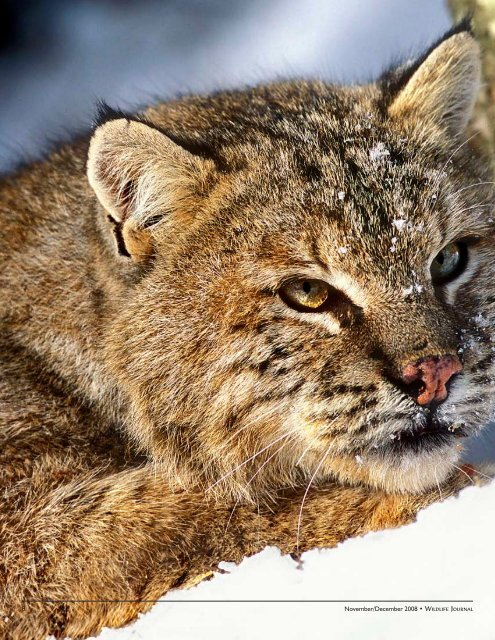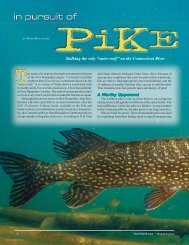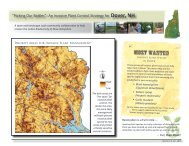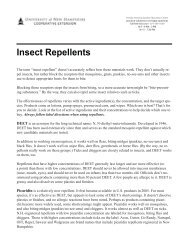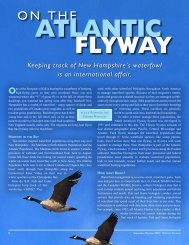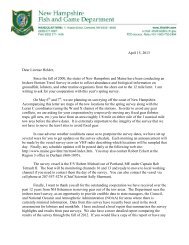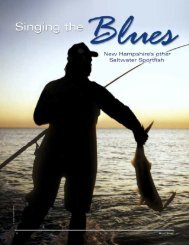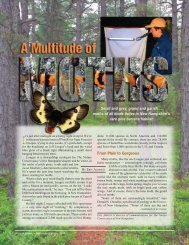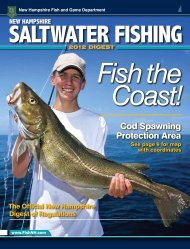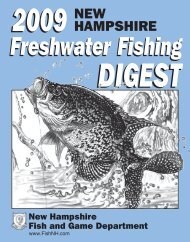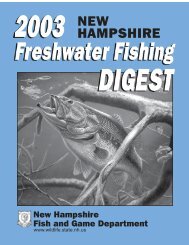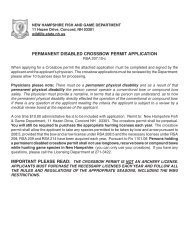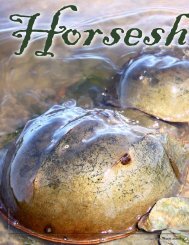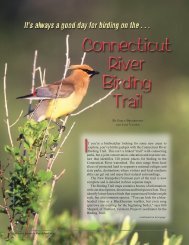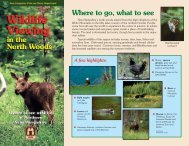Where the Wild Cat Roams - New Hampshire Fish and Game ...
Where the Wild Cat Roams - New Hampshire Fish and Game ...
Where the Wild Cat Roams - New Hampshire Fish and Game ...
- No tags were found...
Create successful ePaper yourself
Turn your PDF publications into a flip-book with our unique Google optimized e-Paper software.
North American bobcat(Lynx rufus)A stubby tail gives <strong>the</strong> bobcat its name, but here are <strong>the</strong> o<strong>the</strong>r features of this NorthAmerican wildcat:U The average weight is 15 pounds for females; 26 for males.U The average length is 31 inches for females; 34 for males.U It has ear tufts that are shorter than one inch <strong>and</strong> also tufts of hair around its cheeks thatgive its face a squarish appearance.U A bobcat’s hind legs are longer than its forelegs, helping it to pounce <strong>and</strong> catch cottontailrabbits, snowshoe hare, mice, squirrels, groundhogs, birds <strong>and</strong> even porcupines. It alsowill catch prey as small as insects – or as large as white-tailed deer.U Litters can range from one kitten to as many as 6, but <strong>the</strong> average litter size is 2 or 3.U Tracks me<strong>and</strong>er in a formation similar to one that a housecat would leave, but <strong>the</strong> tracksare bigger: 1¾ to 2½ inches long <strong>and</strong> 1¾ to 2½ inches wide in dirt; 2½ inches long <strong>and</strong>2¾ inches wide in snow. Claw marks are not visible.©usda / terry spivey photo / bugwood.org©roger irwin photo©john davy photo©roger irwin photofrom sou<strong>the</strong>rn Canada to central Mexico. Increasingpelt prices <strong>and</strong> fear of possible overharvest resultedin <strong>the</strong> listing of <strong>the</strong> bobcat on Appendix II of <strong>the</strong>Convention on International Trade in EndangeredSpecies (CITES). This ensured that internationaltrade would not harm <strong>the</strong> survival of <strong>the</strong> bobcat asa species. Oversight responsibility ultimately fell to<strong>the</strong> U.S. <strong>Fish</strong> &<strong>Wild</strong>life Service, which worked withstates to protect <strong>the</strong> bobcat from overharvest, whileallowing states to keep some form of hunting <strong>and</strong>trapping if appropriate. <strong>New</strong> <strong>Hampshire</strong> decided toclose <strong>the</strong> bobcat season <strong>and</strong> make it illegal to hunt ortrap bobcats, because <strong>the</strong>re were so few in <strong>the</strong> state.“Around 1984 is when we were seeing a populationdecline in <strong>New</strong> <strong>Hampshire</strong>, to <strong>the</strong> point where onlyabout two dozen bobcats a year were being huntedor trapped,” says John Litvaitis, a wildlife ecologyprofessor at <strong>the</strong> University of <strong>New</strong> <strong>Hampshire</strong>. “Thepopulation had reached such a low point that trackinga small harvest would mean a lot of effort for <strong>the</strong>state.”“Bobcats are an odd duck, so to speak, in that <strong>the</strong>yare not listed as an endangered species, but <strong>the</strong>y stillhave a fair amount of federal oversight,” Litvaitissays. The N.H. <strong>Wild</strong>life Action Plan lists bobcats asa species of greatest conservation need in <strong>the</strong> state– mostly because of a decline in available bobcathabitat, <strong>and</strong> in part because <strong>the</strong>ir current populationnumbers are not known.Tracking <strong>the</strong> <strong>Cat</strong>sIn early 2009, trappers will have a chance to see<strong>the</strong>se beauties up close if <strong>the</strong>y participate in a livecaptureresearch study being conducted by N.H. <strong>Fish</strong><strong>and</strong> <strong>Game</strong> <strong>and</strong> <strong>the</strong> University of <strong>New</strong> <strong>Hampshire</strong>.Litvaitis says that involving people who are alreadyknowledgeable about trapping seemed a natural fitfor this research.“Trapping a bobcat is more of an intellectual challengeof matching wits than it is with a coyote or afisher,” says Litvaitis, who will head <strong>the</strong> researchteam for N.H. <strong>Fish</strong> <strong>and</strong> <strong>Game</strong>. “Getting a bobcat tostep into your trap is a real talent <strong>and</strong> a lot of luck.”Along with luck, <strong>the</strong> trappers will learn <strong>the</strong> researchprotocol for catching bobcats using modified, paddedleg hold traps, which are a type of trap listed by <strong>the</strong>U.S. Department of Agriculture for wildlife relocationefforts. These have been successfully used for bobcatBobcats exhibit short black ear tufts; retractableclaws; <strong>and</strong> white patches of fur behind <strong>the</strong> ears.10 November/December 2008 • <strong>Wild</strong>life Journal
If you’ve ever walked in <strong>the</strong>forests of southwestern <strong>New</strong><strong>Hampshire</strong>, <strong>the</strong>re’s a goodchance that a pair ofyellow eyes was watchingyour every move.©alan briere photoA great deal of potential bobcathabitat is included in l<strong>and</strong>s thatmake up <strong>the</strong> proposed Quabbinto-Cardiganproject,shown at right in yellow.Any l<strong>and</strong>s conservedin this region have<strong>the</strong> potential toimprove conditions<strong>and</strong>connectivityfor <strong>New</strong><strong>Hampshire</strong>’sbobcats.ways that we can connect habitats,” Brunkhurst says.“Through <strong>the</strong>ir movements, <strong>the</strong> bobcats will help usunderst<strong>and</strong> what <strong>the</strong>y – <strong>and</strong> o<strong>the</strong>r animals with similarhabitat requirements – really need in terms of space<strong>and</strong> connectivity.”Like humans creating a well-worn path, bobcatsmost likely have regular routes <strong>the</strong>y use to get to hunting<strong>and</strong> breeding grounds. When new infrastructuresuch as roads <strong>and</strong> buildings are built on or near <strong>the</strong>sebobcat paths, researchers want to learn how well <strong>the</strong>animal adapts.“Coyotes <strong>and</strong> o<strong>the</strong>r predators seem to respond <strong>and</strong>adapt to human development, but bobcats just don’tseem to get <strong>the</strong> idea, <strong>and</strong> <strong>the</strong>y endup crossing roads more often,” saysLitvaitis. “If we want a healthy bobcatpopulation in <strong>New</strong> <strong>Hampshire</strong>, wehave to be much more earnest in finding<strong>and</strong> setting aside <strong>the</strong> importanttravel connections that <strong>the</strong>y use.”Such habitat connections maybe found within <strong>the</strong> proposedQuabbin-to-Cardigan ConservationCollaborative, which is an effortby 23 public <strong>and</strong> private partnersto create 100-plus miles of conservationl<strong>and</strong>s stretching from<strong>the</strong> Quabbin Reservoir in centralMassachusetts up to <strong>the</strong> WhiteMountains. All of <strong>the</strong> countiestargeted for <strong>the</strong> bobcat studyfall within <strong>the</strong> Quabbin-to-Cardigan project, so Litvaitissays that identifying bobcatsin this area could “add animportant dimension”to both <strong>the</strong> bobcatstudy <strong>and</strong> <strong>the</strong>l<strong>and</strong> conservationinitiative.Genetic CluesAlong with collaring <strong>and</strong> tracking bobcats, <strong>the</strong>research team will be on <strong>the</strong> lookout for those telltalesigns that even <strong>the</strong> domestic cat leaves behind:hair <strong>and</strong> scat. Like household cats using a litter box,bobcats often will cover up urine or feces, making <strong>the</strong>waste difficult for researchers to find, especially in <strong>the</strong>snow. But like <strong>the</strong> domestic kitty-cat that scratches itsclaws on <strong>the</strong> living room sofa <strong>and</strong> wipes its face (<strong>and</strong>scent) against <strong>the</strong> loveseat, <strong>the</strong> bobcat uses its favoritetree stumps to leave its mark. Researchers usually canfind hair left behind on <strong>the</strong>se stumps <strong>and</strong> o<strong>the</strong>r “scentstations.” The hair will be used to collect DNA, whichwill be checked against <strong>the</strong> database of DNA alreadyga<strong>the</strong>red from radio-collared bobcats in <strong>the</strong> state. If<strong>the</strong> DNA isn’t a match with <strong>the</strong> collared cats, <strong>the</strong>n <strong>the</strong>research team can add ano<strong>the</strong>r individual bobcat to<strong>the</strong>ir roster. This total list of bobcat DNA will be usedto estimate <strong>the</strong> bobcat population in <strong>New</strong> <strong>Hampshire</strong>.This number will <strong>the</strong>n be compared to <strong>the</strong> populationdensities found in Maine, Vermont, <strong>and</strong> Massachusetts– our three neighboring states where, unlike in <strong>New</strong><strong>Hampshire</strong>, limited bobcat trapping is allowed in latefall or winter of each year.The DNA <strong>and</strong> radio-collar data will enable N.H.<strong>Fish</strong> <strong>and</strong> <strong>Game</strong> <strong>and</strong> <strong>the</strong> University of <strong>New</strong> <strong>Hampshire</strong>to uncover new insights into this secretive cat. For<strong>the</strong> first time, scientists will be able to document <strong>the</strong>bobcat population’s size, whereabouts <strong>and</strong> habitatrequirements in <strong>the</strong> state. With <strong>the</strong>se insights, we canall work toge<strong>the</strong>r to help ensure that this elusive felinepresence continues to grace <strong>the</strong> l<strong>and</strong>scape for generationsto come.Linda Saucerman is a freelance writer from Dover,N.H., specializing in environmental journalism <strong>and</strong>travel writing. When not typing at her computer, sheenjoys hiking with her husb<strong>and</strong> <strong>and</strong> dog <strong>and</strong> taking<strong>the</strong> time to peek under logs <strong>and</strong> rocks along <strong>the</strong> trail.12 November/December 2008 • <strong>Wild</strong>life Journal


